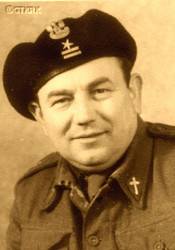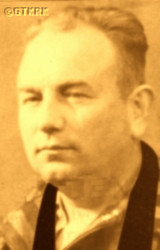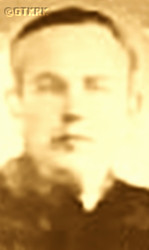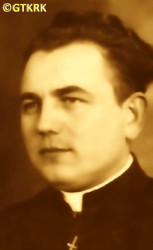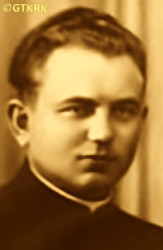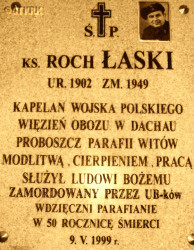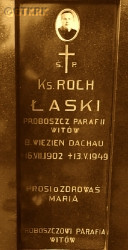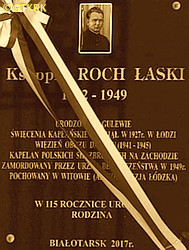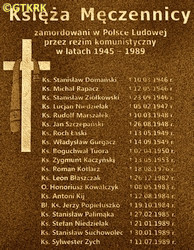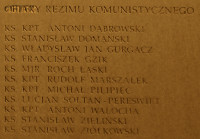Roman Catholic
St Sigismund parish
05-507 Słomczyn
85 Wiślana Str.
Konstancin deanery
Warsaw archdiocese, Poland
full list:
displayClick to display full list

searchClick to search full list by categories
wyświetlKliknij by wyświetlić pełną listę po polsku

szukajKliknij by przeszukać listę wg kategorii po polsku

Martyrology of the clergy — Poland
XX century (1914 – 1989)
personal data
surname
ŁASKI
forename(s)
Rock (pl. Roch)
function
diocesan priest
creed
Latin (Roman Catholic) Church RCmore on
en.wikipedia.org
[access: 2014.09.21]
diocese / province
Łódź diocesemore on
en.wikipedia.org
[access: 2013.05.19]
RC Military Ordinariate of Polandmore on
en.wikipedia.org
[access: 2014.12.20]
honorary titles
„Polonia Restituta” Cross — 3rd Class, Commander'smore on
„Polonia Restituta” Cross – 3rd_Class, Commander's
(24.07.2017)
Commemorative Medal for War of 1918–21more on
Commemorative Medal for War of 1918-21
date and place
of death
13.05.1949

Łódźtoday: Łódź city pov., Łódź voiv., Poland
more on
en.wikipedia.org
[access: 2021.07.18]
details of death
Participant of the Polish–Russian war 1919‐1921 — as a scout was drafted into 201st Voluntary Infantry Regiment. After the Polish victory in the so‐called Battle of Warsaw in 08.1920 („Miracle on the Vistula”) takes part with his unit in the battles on the northern front (perhaps took part in the so‐called Battle of the Nemanas, victorious for the Poles, on 20‐28.09.1920). Then, along with his squad, prob. joined the grouping under the command of Gen. Lucien Żeligowski, who in 10.1920 formally „rebelled” against the Commander‐in‐Chief Joseph Piłsudski (informally all actions were carried out with his knowledge and upon his initiative) and captured Vilnius — from Lithuanians, whom the fleeing Russians „handed over” the city. And then on 18.10.1919 was captured by Lithuanians near Trakai near Vilnius. Held in POW camp in Kaunas, but managed to escape. Demobilized in 12.1920.
After German invasion of Poland on 01.09.1939 (Russians invaded Poland 17 days later) and start of the World War II, volunteered for the Polish Army.
Assigned as a chaplain to the 22nd Infantry Regiment, within the 9th Infantry Division of the Army of „Pomerania”, took part in the defensive war of 1939.
Took part in the defense of Warsaw.
After its fall on 27.09.1939, the Polish defeat and the start of the German occupation, avoids German captivity and returns to his parish.
There arrested by the Germans on 06.10.1941, as part of the action to eliminate the Polish Catholic clergy in the Germ. Reichsgau Wartheland province, established in the occupied Greater Poland region.
Held in DL Konstantinow transit camp.
On 30.10.1941 transported to KL Dachau concentration camp.
Survived concentration camps and on 29.04.1945 was liberated by American troops.
Became a chaplain, in rank of mayor, of Polish Armed Forces in the West. Ministered in Camp No. 2 for Displaced Persons DP in Göttingen.
On 14.06.1946 returned to Russian–controlled Poland.
Next arrested many times by Russian controlled Commie‐Nazi security services UB.
Dragged to a nearby forests and repeatedly maltreated and beaten.
On 15.04.1949 (Good Friday) arrested when saying Mass.
Tortured.
Few days later released but died from injuries in hospital.
During a family visit said that UB had told him that „he might have had survived KL Dachau concentration camp, but UB had better methods though”.
Posthumously promoted to the military rank of lieutenant colonel.
prisoner camp's numbers
28328Click to display source page (KL DachauClick to display the description)
cause of death
murder
perpetrators
Russians / Poles
sites and events
KL DachauClick to display the description, DL KonstantinowClick to display the description, 06.10.1941 arrests (Warthegau)Click to display the description, Reichsgau WarthelandClick to display the description, Ribbentrop‐MolotovClick to display the description, Pius XI's encyclicalsClick to display the description, Polish‐Russian war of 1919‐1921Click to display the description
date and place
of birth
16.08.1902Birth certification on:
photos.szukajwarchiwach.gov.pl
[access: 2025.03.15]

Gulewotoday: Gostynin gm., Gostynin pov., Masovia voiv., Poland
more on
en.wikipedia.org
[access: 2022.01.28]
parents
ŁASKI Michael
🞲 ?, ? — 🕆 ?, ?

ZYDEL Josefa
🞲 ?, ? — 🕆 ?, ?
baptism
21.08.1902Birth certification on:
photos.szukajwarchiwach.gov.pl
[access: 2025.03.15]

Białotarsktoday: Gostynin gm., Gostynin pov., Masovia voiv., Poland
more on
en.wikipedia.org
[access: 2022.01.10]
Transfiguration of the Lord RC church
presbyter (holy orders)
ordination
13.11.1927

Łódźtoday: Łódź city pov., Łódź voiv., Poland
more on
en.wikipedia.org
[access: 2021.07.18]
St Stanislav Kostka the Confessor RC cathedral churchmore on
en.wikipedia.org
[access: 2025.03.14]
positions held
1946 – 1949
administrator — Witówtoday: Sulejów gm., Piotrków Trybunalski pov., Łódź voiv., Poland
more on
en.wikipedia.org
[access: 2021.12.18] ⋄ St Margaret and St Augustine RC parish ⋄ Piotrków Trybunalskitoday: Piotrków Trybunalski city pov., Łódź voiv., Poland
more on
en.wikipedia.org
[access: 2021.07.29] RC deanery
1946
priest — Żeronietoday: Grabica gm., Piotrków Trybunalski pov., Łódź voiv., Poland
more on
en.wikipedia.org
[access: 2021.12.18] ⋄ Our Lady of Częstochowa RC parish ⋄ Pabianicetoday: Pabianice urban gm., Pabianice pov., Łódź voiv., Poland
more on
en.wikipedia.org
[access: 2021.12.18] RC deanery
1945 – 1946
RC military chaplain — Göttingentoday: Göttingen dist., Lower Saxony state, Germany
more on
en.wikipedia.org
[access: 2022.04.17] ⋄ Camp No. 2 for Displaced Persons DP, Polish Armed Forces (formed „in the West”), Polish Armed Forces
1934 – 1941
parish priest — Żeronietoday: Grabica gm., Piotrków Trybunalski pov., Łódź voiv., Poland
more on
en.wikipedia.org
[access: 2021.12.18] ⋄ Our Lady of Częstochowa RC parish ⋄ Pabianicetoday: Pabianice urban gm., Pabianice pov., Łódź voiv., Poland
more on
en.wikipedia.org
[access: 2021.12.18] RC deanery
1932 – 1934
parish priest — Łękawatoday: Bełchatów gm., Bełchatów pov., Łódź voiv., Poland
more on
en.wikipedia.org
[access: 2022.07.16] ⋄ Nativity of the Blessed Virgin Mary RC parish ⋄ Bełchatówtoday: Bełchatów urban gm., Bełchatów pov., Łódź voiv., Poland
more on
en.wikipedia.org
[access: 2021.12.18] RC deanery
1931 – 1932
vicar — Łódźtoday: Łódź city pov., Łódź voiv., Poland
more on
en.wikipedia.org
[access: 2021.07.18] ⋄ St Stanislav Kostka the Confessor RC cathedral parish ⋄ Łódźtoday: Łódź city pov., Łódź voiv., Poland
more on
en.wikipedia.org
[access: 2021.07.18] RC deanery — also: chaplain of the chapel at the Stanislav Staszic's elementary school in Łódź–Rokicie, chaplain of the Alexander's municipal hospital, prefect of elementary schools
1930 – 1931
chaplain — ŁódźRokicie neighborhood
form.: village
today: Łódź city pov., Łódź voiv., Poland
more on
en.wikipedia.org
[access: 2021.07.18] ⋄ RC chapel (by the Stanislav Staszic's elementary school) ⋄ Łódźtoday: Łódź city pov., Łódź voiv., Poland
more on
en.wikipedia.org
[access: 2021.07.18] RC deanery — also: prefect of elementary schools
1929 – 1930
prefect — Poddębicetoday: Poddębice gm., Poddębice pov., Łódź voiv., Poland
more on
en.wikipedia.org
[access: 2021.12.18] ⋄ primary schools ⋄ St Catherine the Virgin and Martyr RC parish ⋄ Poddębicetoday: Poddębice gm., Poddębice pov., Łódź voiv., Poland
more on
en.wikipedia.org
[access: 2021.12.18] RC deanery
1928 – 1929
prefect — Ruda Pabianickatoday: neighborhood in Łódź, Łódź city pov., Łódź voiv., Poland
more on
en.wikipedia.org
[access: 2021.07.18] ⋄ primary schools ⋄ St Joseph Spouse of the Blessed Virgin Mary RC parish ⋄ Pabianicetoday: Pabianice urban gm., Pabianice pov., Łódź voiv., Poland
more on
en.wikipedia.org
[access: 2021.12.18] RC deanery
1927 – c. 1928
prefect — Jeżówtoday: Jeżów gm., Brzeziny pov., Łódź voiv., Poland
more on
en.wikipedia.org
[access: 2020.11.27] ⋄ primary schools ⋄ St Joseph Spouse of the Blessed Virgin Mary RC parish ⋄ Brzezinytoday: Brzeziny urban gm., Brzeziny pov., Łódź voiv., Poland
more on
en.wikipedia.org
[access: 2020.11.27] RC deanery
1922 – 1927
student — Łódźtoday: Łódź city pov., Łódź voiv., Poland
more on
en.wikipedia.org
[access: 2021.07.18] ⋄ philosophy and theology, Theological Seminary
sites and events
descriptions
KL Dachau: KL Dachau in German Bavaria, set up in 1933, became the main German Germ. Konzentrationslager (Eng. concentration camp) KL for Catholic priests and religious during World War II: On c. 09.11.1940, Reichsführer‐SS Heinrich Himmler, head of the SS, Gestapo and German police, as a result of the Vatican's intervention, decided to transfer all clergymen detained in various concentration camps to KL Dachau camp. The first major transports took place on 08.12.1940. In KL Dachau Germans held approx. 3,000 priests, including 1,800 Poles. The priests were forced to slave labor in the Germ. „Die Plantage” — the largest herb garden in Europe, managed by the genocidal SS, consisting of many greenhouses, laboratory buildings and arable land, where experiments with new natural medicines were conducted — for many hours, without breaks, without protective clothing, no food. They slaved in construction, e.g. of camp's crematorium. In the barracks ruled hunger, freezing cold in the winter and suffocating heat during the summer, especially acute in 1941‐1942. Prisoners suffered from bouts of illnesses, including tuberculosis. Many were victims of murderous „medical experiments” — in 11.1942 c. 20 were given phlegmon injections; in 07.1942 to 05.1944 c. 120 were used by for malaria experiments. More than 750 Polish clerics where murdered by the Germans, some brought to TA Hartheim euthanasia centre set up in Schloss Hartheim in Austria and murdered in gas chambers. At its peak KL Dachau concentration camps’ system had nearly 100 slave labour sub‐camps located throughout southern Germany and Austria. There were c. 32,000 documented deaths at the camp, and thousands perished without a trace. C. 10,000 of the 30,000 inmates were found sick at the time of liberation, on 29.04.1945, by the USA troops… (more on: www.kz-gedenkstaette-dachau.deClick to attempt to display webpage
[access: 2013.08.10], en.wikipedia.orgClick to attempt to display webpage
[access: 2016.05.30])
DL Konstantinow: Germ. Durchgangslager Konstantinow (Eng. Transit Camp) — resettlement concentration camp established on 05.01.1940 in Konstantynów Łódzki (c. 10 km west of the center of Łódź), and operational till 16.08.1943. Polish prisoners from Greater Poland (Wielkopolska), Pomerania and central Poland were held there. Approx. 42,000 were interned, thousands of them perished out of which approx. 700 were identified. In 10.1941‐12.1941 approx. 450 Polish priests and religious from Częstochowa, Łódź and Włocławek dioceses and Poznań archdiocese were imprisoned there prior to transport to KL Dachau concentration camp. (more on: pl.wikipedia.orgClick to attempt to display webpage
[access: 2013.08.10], ipn.gov.plClick to attempt to display webpage
[access: 2021.12.19])
06.10.1941 arrests (Warthegau): On 13.09.1941 Germ. Gauleiter (Eng. regional leader) of German province Germ. Reichsgau Wartheland (Eng. Wartheland Reich district), in German‐occupied Greater Poland (where German standard law was in force), Artur Greiser, implementing „Ohne Gott, ohne Religion, ohne Priesters und Sakramenten” — „without God, without religion, without priest and sacrament” — policy issued a decree formally dissolving Catholic Church and forming in its place a Roman Catholic German National Church in Germ. Warthegau, an organization subject to a German private law. The ordinance was issued backdated to 01.09.1939, i.e. the date of the German invasion of Poland, which sanctioned the later robbery of the property of the Catholic Church acting for the benefit of the Polish population by the Germans. All the contacts with Vatican were forbidden. All the religion congregations were also dissolved. Soon after, on 06‐07.10.1941, mass arrests of Polish Catholic priests took place — c. 352 were detained. All were herded into DL Konstantinow in Konstantynów or IL Lond in Ląd on Warta river transit camps or KL Posen concentration camp (in this case, the detainees were first registered, photographed and examined in the infamous Poznań headquarters of the German political police, the Gestapo, in the former Soldier's House). On 30.10.1941 most of them were transported to KL Dachau concentration camp.
Reichsgau Wartheland: After the Polish defeat in the 09.1939 campaign, which was the result of the Ribbentrop‐Molotov Pact and constituted the first stage of World War II, and the beginning of German occupation in part of Poland (in the other, eastern part of Poland, the Russian occupation began), the Germans divided the occupied Polish territory into five main regions (and a few smaller). The largest one was transformed into Germ. Generalgouvernement (Eng. General Governorate), intended exclusively for Poles and Jews and constituting part of the so‐called Germ. Großdeutschland (Eng. Greater Germany). Two were added to existing German provinces. From two other separate new provinces were created. Greater Poland region was one of them, incorporated into Germany on 08.10.1939, by decree of the German leader Adolf Hitler (formally came into force on 26.10.1939), and on 24.01.1940 transformed into the Germ. Reichsgau Wartheland province, in which the law of the German state was to apply. The main axis of the policy of the new province, the territory of which the Germans recognized as the Germ. „Ursprünglich Deutsche” (Eng. „natively German”), despite the fact that 90% of its inhabitants were Poles, was Germ. „Entpolonisierung” (Eng. „Depolonisation”), i.e. forced Germanization. C. 100,000 Poles were murdered as part of the Germ. „Intelligenzaktion”, i.e. extermination of Polish intelligentsia and ruling classes. C. 630,000 were forcibly resettled to the Germ. Generalgouvernement, and their place taken by the Germans brought from other areas occupied by Germany (e.g. the Baltic countries, Bessarabia, Bukovina, etc.). Poles were forced to sign the German nationality list, the Germ. Deutsche Volksliste DVL. As part of the policy of „Ohne Gott, ohne Religion, ohne Priesters und Sakramenten” (Eng. „No God, no religion, no priest or sacrament”) most Catholic priests were arrested and sent to concentration camps. All schools teaching in Polish, Polish libraries, theaters and museums were closed. Polish landed estates confiscated. To further reduce the number of the Polish population, Poles were sent to forced labor deep inside Germany, and the legal age of marriage for Poles was increased (25 for women, 28 for men). The German state office, Germ. Rasse‐ und Siedlungshauptamt (Eng. Main Office of Race and Settlement) RuSHA, under the majesty of German law, abducted several thousand children who met specific racial criteria from Polish families and subjected them to forced Germanization, handing them over to German families. After the end of hostilities of World War II, the overseer of this province, the Germ. Reichsstatthalter (Eng. Reich Governor) and the Germ. Gauleiter (Eng. district head) of the German National Socialist Party, Arthur Karl Greiser, was executed. (more on: en.wikipedia.orgClick to attempt to display webpage
[access: 2024.06.21])
Ribbentrop‐Molotov: Genocidal Russian‐German alliance pact between Russian leader Joseph Stalin and German leader Adolf Hitler signed on 23.08.1939 in Moscow by respective foreign ministers, Mr. Vyacheslav Molotov for Russia and Joachim von Ribbentrop for Germany. The pact sanctioned and was the direct cause of joint Russian and German invasion of Poland and the outbreak of the World War II in 09.1939. In a political sense, the pact was an attempt to restore the status quo ante before 1914, with one exception, namely the „commercial” exchange of the so‐called „Kingdom of Poland”, which in 1914 was part of the Russian Empire, fore Eastern Galicia (today's western Ukraine), in 1914 belonging to the Austro‐Hungarian Empire. Galicia, including Lviv, was to be taken over by the Russians, the „Kingdom of Poland” — under the name of the General Governorate — Germany. The resultant „war was one of the greatest calamities and dramas of humanity in history, for two atheistic and anti‐Christian ideologies — national and international socialism — rejected God and His fifth Decalogue commandment: Thou shall not kill!” (Abp Stanislav Gądecki, 01.09.2019). The decisions taken — backed up by the betrayal of the formal allies of Poland, France and Germany, which on 12.09.1939, at a joint conference in Abbeville, decided not to provide aid to attacked Poland and not to take military action against Germany (a clear breach of treaty obligations with Poland) — were on 28.09.1939 slightly altered and made more precise when a treaty on „German‐Russian boundaries and friendship” was agreed by the same murderous signatories. One of its findings was establishment of spheres of influence in Central and Eastern Europe and in consequence IV partition of Poland. In one of its secret annexes agreed, that: „the Signatories will not tolerate on its respective territories any Polish propaganda that affects the territory of the other Side. On their respective territories they will suppress all such propaganda and inform each other of the measures taken to accomplish it”. The agreements resulted in a series of meeting between two genocidal organization representing both sides — German Gestapo and Russian NKVD when coordination of efforts to exterminate Polish intelligentsia and Polish leading classes (in Germany called «Intelligenzaktion», in Russia took the form of Katyń massacres) where discussed. Resulted in deaths of hundreds of thousands of Polish intelligentsia, including thousands of priests presented here, and tens of millions of ordinary people,. The results of this Russian‐German pact lasted till 1989 and are still in evidence even today. (more on: en.wikipedia.orgClick to attempt to display webpage
[access: 2015.09.30])
Pius XI's encyclicals: Facing the creation of two totalitarian systems in Europe, which seemed to compete with each other, though there were more similarities than contradictions between them, Pope Pius XI issued in 03.1937 (within 5 days) two encyclicals. In the „Mit brennender Sorge” (Eng. „With Burning Concern”) published on 14.03.1938, condemned the national socialism prevailing in Germany. The Pope wrote: „Whoever, following the old Germanic‐pre‐Christian beliefs, puts various impersonal fate in the place of a personal God, denies the wisdom of God and Providence […], whoever exalts earthly values: race or nation, or state, or state system, representatives of state power or other fundamental values of human society, […] and makes them the highest standard of all values, including religious ones, and idolizes them, this one […] is far from true faith in God and from a worldview corresponding to such faith”. On 19.03.1937, published „Divini Redemptoris” (Eng. „Divine Redeemer”), in which criticized Russian communism, dialectical materialism and the class struggle theory. The Pope wrote: „Communism deprives man of freedom, and therefore the spiritual basis of all life norms. It deprives the human person of all his dignity and any moral support with which he could resist the onslaught of blind passions […] This is the new gospel that Bolshevik and godless communism preaches as a message of salvation and redemption of humanity”… Pius XI demanded that the established human law be subjected to the natural law of God , recommended the implementation of the ideal of a Christian state and society, and called on Catholics to resist. Two years later, National Socialist Germany and Communist Russia came together and started World War II. (more on: www.vatican.vaClick to attempt to display webpage
[access: 2023.05.28], www.vatican.vaClick to attempt to display webpage
[access: 2023.05.28])
Polish‐Russian war of 1919‐1921: War for independence of Poland and its borders. Poland regained independence in 1918 but had to fight for its borders with former imperial powers, in particular Russia. Russia planned to incite Bolshevik‐like revolutions in the Western Europe and thus invaded Poland. Russian invaders were defeated in 08.1920 in a battle called Warsaw battle („Vistula river miracle”, one of the 10 most important battles in history, according to some historians). Thanks to this victory Poland recaptured part of the lands lost during partitions of Poland in XVIII century, and Europe was saved from the genocidal Communism. (more on: en.wikipedia.orgClick to attempt to display webpage
[access: 2014.12.20])
sources
personal:
bezdekretu.blogspot.comClick to attempt to display webpage
[access: 2013.02.15], swiadkowiehistorii.plClick to attempt to display webpage
[access: 2013.02.15], photos.szukajwarchiwach.gov.plClick to attempt to display webpage
[access: 2025.03.15], www.ordynariat.wp.mil.plClick to attempt to display webpage
[access: 2013.05.19], www.parafiawitow.netstrefa.comClick to attempt to display webpage
[access: 2013.05.19]
original images:
www.parafiawitow.netstrefa.comClick to attempt to display webpage
[access: 2013.05.19], billiongraves.comClick to attempt to display webpage
[access: 2017.01.21], edukacja.ipn.gov.plClick to attempt to display webpage
[access: 2024.01.21], www.radiomaryja.plClick to attempt to display webpage
[access: 2021.12.18], wkrakowie.wordpress.comClick to attempt to display webpage
[access: 2014.01.06], billiongraves.comClick to attempt to display webpage
[access: 2017.01.21], www.radiomaryja.plClick to attempt to display webpage
[access: 2021.12.18], commons.wikimedia.orgClick to attempt to display webpage
[access: 2025.08.19]
LETTER to CUSTODIAN/ADMINISTRATOR
If you have an Email client on your communicator/computer — such as Mozilla Thunderbird, Windows Mail or Microsoft Outlook, described at WikipediaPatrz:
en.wikipedia.org, among others — try the link below, please:
LETTER to CUSTODIAN/ADMINISTRATORClick and try to call your own Email client
If however you do not run such a client or the above link is not active please send an email to the Custodian/Administrator using your account — in your customary email/correspondence engine — at the following address:

giving the following as the subject:
MARTYROLOGY: ŁASKI Rock
To return to the biography press below:
 Click to return to biography
Click to return to biography








